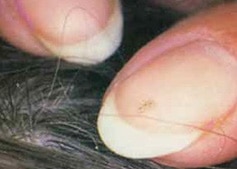PDF 241 KB
What you need to know about wet combing and chemical treatments for head lice. Includes steps on how to effectively treat using both treatment options
 Head lice are small wingless biting insects which live and breed in human hair and feed by sucking blood from the scalp.
Head lice are small wingless biting insects which live and breed in human hair and feed by sucking blood from the scalp.
Outbreaks of head lice are common in children in schools and institutions everywhere. They infest people of all socio-economic positions and age groups.
Spread is by direct head-to-head contact with a person who has head lice, or more rarely by contact with items which have been recently used by someone with head lice, such as:
Some animals have lice, but lice which live on animals will not live on humans.
Many lice infestations cause no symptoms and probably less than half cause itching, so you have to look at the hair to see if lice are present.

Use a bright light or sunlight to inspect the hair. You may see small white or brown oblong eggs ('nits') attached to the shafts, and they are difficult to move. The live lice are more difficult to find as they move rapidly away from disturbances in the hair. Adult lice are 2 to 4mm long and whitish brown (see images).
The best way to check for head lice is to apply a  generous amount of hair conditioner (any brand will do), then dry the hair and comb through with a coarse comb to detangle the hair. The conditioner stuns head lice for about 20 minutes. Then use a very fine toothed comb and comb the hair through, wiping it on a tissue regularly so you can check for lice and their eggs.
generous amount of hair conditioner (any brand will do), then dry the hair and comb through with a coarse comb to detangle the hair. The conditioner stuns head lice for about 20 minutes. Then use a very fine toothed comb and comb the hair through, wiping it on a tissue regularly so you can check for lice and their eggs.
(time between becoming infected and developing symptoms)
The eggs usually hatch in 7 to 10 days.
(time during which an infected person can infect others)
As long as the eggs or lice are alive. Once hatched, the lice are capable of laying eggs after 10 days and lice live for up to 35 days on the scalp. They do not survive more than 2 days away from a human host.
A number of head lice treatments are available without prescription. Follow directions on the packaging. The two most common head lice treatment methods are:
See, How to get rid of head lice using the wet combing technique (PDF 408KB) for what you’ll need, and the steps used for both wet combing and chemical treatment options.
Ensure you seek medical advice before using treatments on:
Family members may also need treatment.
Re-treatment after 7 to 10 days is necessary because lice in unhatched eggs may not be killed by the first treatment. If head lice are still found after the second treatment, try another technique or another chemical treatment using a different active ingredient. If infestations persist despite correct insecticide use, seek medical advice on alternative methods of treatment.
Head lice infestation can be prevented by the following measures: